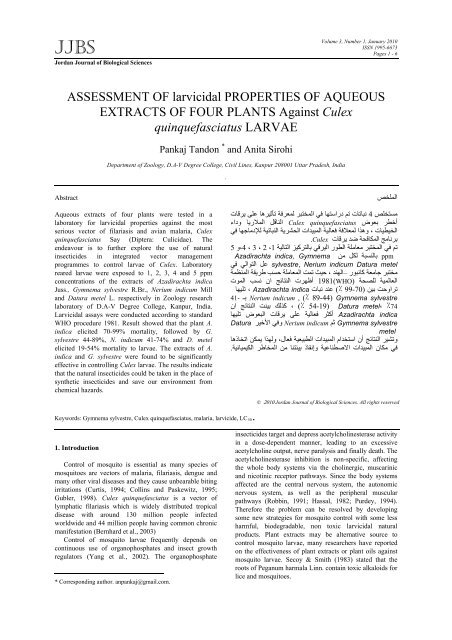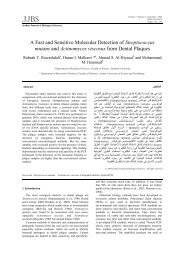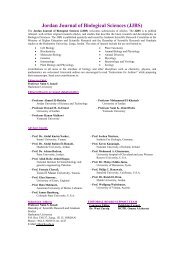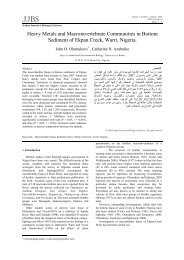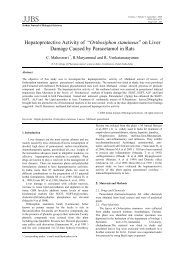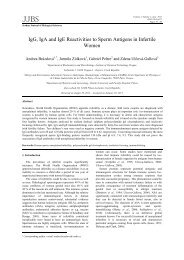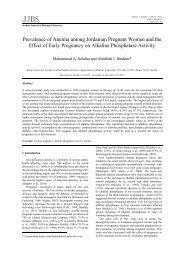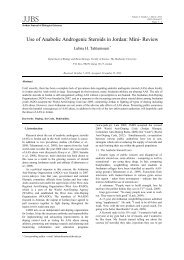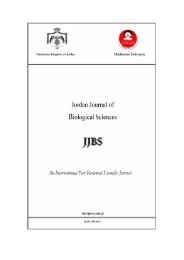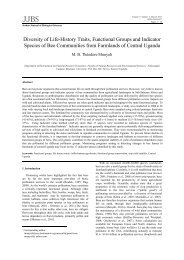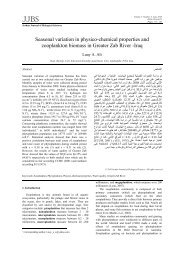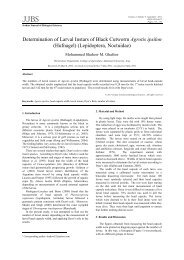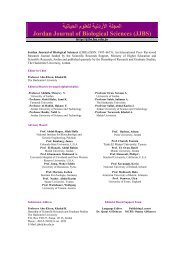ASSESSMENT OF larvicidal PROPERTIES OF AQUEOUS ...
ASSESSMENT OF larvicidal PROPERTIES OF AQUEOUS ...
ASSESSMENT OF larvicidal PROPERTIES OF AQUEOUS ...
You also want an ePaper? Increase the reach of your titles
YUMPU automatically turns print PDFs into web optimized ePapers that Google loves.
JJBS<br />
Jordan Journal of Biological Sciences<br />
Volume 3, Number 1, January 2010<br />
ISSN 1995-6673<br />
Pages 1 - 6<br />
<strong>ASSESSMENT</strong> <strong>OF</strong> <strong>larvicidal</strong> <strong>PROPERTIES</strong> <strong>OF</strong> <strong>AQUEOUS</strong><br />
EXTRACTS <strong>OF</strong> FOUR PLANTS Against Culex<br />
quinquefasciatus LARVAE<br />
Pankaj Tandon * and Anita Sirohi<br />
Department of Zoology, D.A-V Degree College, Civil Lines, Kanpur 208001 Uttar Pradesh, India<br />
.<br />
Abstract ﺺ ﺨﻠﻤﻟا<br />
Aqueous extracts of four plants were tested in a<br />
laboratory for <strong>larvicidal</strong> properties against the most<br />
serious vector of filariasis and avian malaria, Culex<br />
quinquefasciatus Say (Diptera: Culicidae). The<br />
endeavour is to further explore the use of natural<br />
insecticides in integrated vector management<br />
programmes to control larvae of Culex. Laboratory<br />
reared larvae were exposed to 1, 2, 3, 4 and 5 ppm<br />
concentrations of the extracts of Azadirachta indica<br />
Juss., Gymnema sylvestre R.Br., Nerium indicum Mill<br />
and Datura metel L. respectively in Zoology research<br />
laboratory of D.A-V Degree College, Kanpur, India.<br />
Larvicidal assays were conducted according to standard<br />
WHO procedure 1981. Result showed that the plant A.<br />
indica elicited 70-99% mortality, followed by G.<br />
sylvestre 44-89%, N. indicum 41-74% and D. metel<br />
elicited 19-54% mortality to larvae. The extracts of A.<br />
indica and G. sylvestre were found to be significantly<br />
effective in controlling Culex larvae. The results indicate<br />
that the natural insecticides could be taken in the place of<br />
synthetic insecticides and save our environment from<br />
chemical hazards.<br />
تﺎﻗﺮﻳ ﻰﻠﻋ ﺎهﺮﻴﺛﺄﺗ ﺔﻓﺮﻌﻤﻟ ﺮﺒﺘﺨﻤﻟا ﻲﻓ ﺎﻬﺘﺳارد ﻢﺗ تﺎﺗﺎﺒﻧ 4 ﺺﻠﺨﺘﺴﻣ<br />
ءادو ﺎﻳرﻼﻤﻟا ﻞﻗﺎﻨﻟا<br />
Culex quinquefasciatus ضﻮﻌﺑ ﺮﻄﺧأ<br />
ﻲﻓ ﺎﻬﺟﺎﻣدﻺﻟ ﺔﻴﺗﺎﺒﻨﻟا ﺔﻳﺮﺸﺤﻟا تاﺪﻴﺒﻤﻟا ﺔﻴﻟﺎﻌﻓ ﺔﻓﻼﻌﻤﻟ اﺬهو ، تﺎﻴﻄﻴﺨﻟا<br />
. Culex تﺎﻗﺮﻳ ﺪﺿ ﺔﺤﻓﺎﻜﻤﻟا ﺞﻣﺎﻧﺮﺑ<br />
5 و،4<br />
، 3 ، 2 ،1<br />
ﺔﻴﻟﺎﺘﻟا ﺰﻴآﺮﺘﻟﺎﺑ ﻲﻗﺮﻴﻟا رﻮﻄﻟا ﺔﻠﻣﺎﻌﻣ ﺮﺒﺘﺨﻤﻟا ﻲﻓ ﻢﺗ<br />
Azadirachta indica, Gymnema ﻦﻣ ﻞﻜﻟ ﺔﺒﺴﻨﻟﺎﺑ ppm<br />
ﻲﻓ ﻲﻟاﻮﺘﻟا ﻞﻋ sylvestre, Nerium indicum Datura metel<br />
ﺔﻤﻈﻨﻤﻟا ﺔﻘﻳﺮﻃ ﺐﺴﺣ ﺔﻠﻣﺎﻌﻤﻟا ﺖﻤﺗ ﺚﻴﺣ ، ﺪﻨﻬﻟا–<br />
رﻮﺒﻧﺎآ ﺔﻌﻣﺎﺟ ﺮﺒﺘﺨﻣ<br />
تﻮﻤﻟا ﺐﺴﻧ نا ﺞﺋﺎﺘﻨﻟا تﺮﻬﻇأ 1981(<br />
WHO)<br />
ﺔﺤﺼﻠﻟ ﺔﻴﻤﻟﺎﻌﻟا<br />
ﺎﻬﻴﻠﺗ ، Azadirachta indica تﺎﺒﻧ ﺪﻨﻋ ( ٪ 99-70)<br />
ﻦﻴﺑ ﺖﺣواﺮﺗ<br />
41- ـﺑ Nerium indicum , ( ٪ 89-44)<br />
Gymnema sylvestre<br />
نا ﺞﺋﺎﺘﻨﻟا ﺖﻨﻴﺑ ﻚﻟﺬآ ، ( ٪ 54-19)<br />
Datura metel،<br />
٪74<br />
ﺎﻬﻴﻠﺗ ضﻮﻌﺒﻟا تﺎﻗﺮﻳ ﻰﻠﻋ ﺔﻴﻟﺎﻌﻓ ﺮﺜآأ Azadirachta indica<br />
Datura ﺮﻴﺧﻷا ﻲﻓو Nerium indicum ﻢﺛ Gymnema sylvestre<br />
metel<br />
ﺎهذﺎﺨﺗا ﻦﻜﻤﻳ اﺬﻬﻟو ،لﺎﻌﻓ ﺔﻴﻌﻴﺒﻄﻟا تاﺪﻴﺒﻤﻟا ماﺪﺨﺘﺳا نأ ﺞﺋﺎﺘﻨﻟا ﺮﻴﺸﺗو<br />
. ﺔﻴﺋﺎﻴﻤﻴﻜﻟا ﺮﻃﺎﺨﻤﻟا ﻦﻣ ﺎﻨﺘﺌﻴﺑ ذﺎﻘﻧإو ﺔﻴﻋﺎﻨﻄﺻﻻا تاﺪﻴﺒﻤﻟا نﺎﻜﻣ ﻲﻓ<br />
© 2010 Jordan Journal of Biological Sciences. All rights reserved<br />
Keywords: Gymnema sylvestre, Culex quinquefasciatus, malaria, larvicide, LC 50.<br />
1. Introduction *<br />
Control of mosquito is essential as many species of<br />
mosquitoes are vectors of malaria, filariasis, dengue and<br />
many other viral diseases and they cause unbearable biting<br />
irritations (Curtis, 1994; Collins and Paskewitz, 1995;<br />
Gubler, 1998). Culex quinquefasciatus is a vector of<br />
lymphatic filariasis which is widely distributed tropical<br />
disease with around 130 million people infected<br />
worldwide and 44 million people having common chronic<br />
manifestation (Bernhard et al., 2003)<br />
Control of mosquito larvae frequently depends on<br />
continuous use of organophosphates and insect growth<br />
regulators (Yang et al., 2002). The organophosphate<br />
* Corresponding author. anpankaj@gmail.com.<br />
insecticides target and depress acetylcholinesterase activity<br />
in a dose-dependent manner, leading to an excessive<br />
acetylcholine output, nerve paralysis and finally death. The<br />
acetylcholinesterase inhibition is non-specific, affecting<br />
the whole body systems via the cholinergic, muscarinic<br />
and nicotinic receptor pathways. Since the body systems<br />
affected are the central nervous system, the autonomic<br />
nervous system, as well as the peripheral muscular<br />
pathways (Robbin, 1991; Hassal, 1982; Purdey, 1994).<br />
Therefore the problem can be resolved by developing<br />
some new strategies for mosquito control with some less<br />
harmful, biodegradable, non toxic <strong>larvicidal</strong> natural<br />
products. Plant extracts may be alternative source to<br />
control mosquito larvae, many researchers have reported<br />
on the effectiveness of plant extracts or plant oils against<br />
mosquito larvae. Secoy & Smith (1983) stated that the<br />
roots of Peganum harmala Linn. contain toxic alkaloids for<br />
lice and mosquitoes.
2<br />
© 2010 Jordan Journal of Biological Sciences. All rights reserved - Volume 3, Number 1<br />
The seed extracts of Sterculia guttata Roxb. (Katade et<br />
al., 2006b); fruit extract of Balanites aegyptiaca Del.<br />
(Wiesman et al., 2006); root extract of Solanum<br />
xanthocarpum Schrad and Wendl. (Mohan et al., 2007);<br />
leaves of Artemisia annua L. and Azadirachta indica Juss.<br />
(Tonk et al 2006); the acetone extract of Nerium indicum<br />
Mill. and Thuja orientelis L. (Sharma et al., 2005) been<br />
tested against the mosquitoes larvae. Oils from 41 plants<br />
tested against Aedes larvae, and out of these only 13 plants<br />
gave 100% mortality (camphor, thyme, amyris, lemon,<br />
cedarwood, frankincense, dill, myrtle, juniper, black<br />
pepper, verbena, helichrysum and sandalwood) after 24<br />
hrs. The best oils were tested against third instar larvae of<br />
Aedes, Anopheles and Culex in 1, 10, 50, 100 and 500<br />
ppm concentration and found extremely prominent results<br />
(Amer and Mehlhorn, 2006).<br />
The Meliaceae plant family is known to contain a<br />
variety of compounds that show insecticidal, antifeedant,<br />
growth regulating properties (D’Ambrosio and Guerriero,<br />
2002). Azadirachta indica commonly known as Neem, is a<br />
deciduous tree native to northwestern India. Its dentate<br />
leaves have long been recognized for insecticidal<br />
properties. Gymnema sylvestre (Gurmar) belongs to<br />
family Asclepiadaceae is an herb native to the southern<br />
and central India. The major bioactive constituents of<br />
Gymnema sylvestre is a group of oleanane type<br />
triterpenoid saponins known as gymnemic acid. Leaves of<br />
this species yield acidic glycosides and anthroquinones.<br />
Datura metel (Angels trumpet) is perennial shrub belongs<br />
to family Solanacae. All parts of plants contain dangerous<br />
level of poison; the principal toxic elements are tropane<br />
alkaloids. Nerium indicum (Kaner) belongs to family<br />
Apocynaceae, it’s a green shrub with milky juice. Root,<br />
bark and seeds contain cardioactive glycosides. The bark<br />
also contains scopoletin and scopoline and small quantity<br />
of tannin, found in gangitic plains and Madhya Pradesh,<br />
India. The present investigation is conducted to study the<br />
<strong>larvicidal</strong> effect of Azadirachta indica, Gymnema<br />
sylvestre, Nerium indicum and Datura metel against larvae<br />
of C. quinquefasciatus Say.<br />
2. Materials and Methods<br />
For preparing the plant extracts to be tested, seeds of A.<br />
indica, leaves of G. sylvestre, bark and leaves of N. indium<br />
and leaves of D. metel were collected and their identity<br />
were confirmed at Botany department of D.A-V Degree<br />
College, Kanpur, India. After that material is cleaned,<br />
chopped, dried in shade and ground to fine powder with<br />
the help of electric grinder. All plants used in present study<br />
were kept safe as voucher specimen in Museum of Botany<br />
department. Extraction of all plant parts was carried out in<br />
a simplest way, thinking that it could be easy for the local<br />
communities to adopt this method. Twenty gram of each<br />
powder was placed in separate glass 100 ml of tap water<br />
was added and mixed vigorously. The mixture was kept<br />
for 24 hours with occasional shaking, after that, mixture<br />
was filtered using a fine muslin cloth and the final volume<br />
adjusted to 100 ml. A series of concentrations 1,2,3,4 and<br />
5 ppm were prepared by using the stock solution using the<br />
tap water.<br />
Culex quinquefasciatus larvae were collected from<br />
stagnant surface water of pools with the help of jar and<br />
stored in enamel trays containing tap water. They were<br />
maintained at 27+ 2 0 C temperature, 70+ 5 0 C relative<br />
humidity under 12:12 light and dark photo period cycle.<br />
The larvae were fed with the fresh food containing finely<br />
grounded dog biscuits and yeast extract in a ratio of 3:2.<br />
Pupae emerged were transferred to new trays containing<br />
tap water and placed in screened cages (30x30x30 cm),<br />
where adult emerged. Adult mosquitoes were fed on a 10%<br />
sucrose solution and 10% multivitamin syrup and<br />
periodically blood fed from fresh blood of rabbit. The egg<br />
masses produced due to adults mating were kept to<br />
continue next generation.<br />
Laboratory reared IV instar larvae of Culex<br />
quinquefasciatus were tested with different concentration<br />
(1-5 ppm) of selected plants extract in Zoology Research<br />
Laboratory, D.A-V Degree College, Kanpur, India during<br />
May to July 2009 according to the standard WHO<br />
procedure (1981). A total of 25 fourth larvae were<br />
introduced in 500 ml glass beaker containing various<br />
concentrations of different plant extracts. The treatments<br />
were replicated four times, and each replicate set contained<br />
one control. Mortalities were reported after 24 hours of the<br />
exposure period. Laboratory room temperature was<br />
maintained at 27+2 0 C during the experiment period. The<br />
moribund and dead larvae in four replicates were<br />
combined and expressed as percentage mortality for each<br />
concentration. Dead larvae were acknowledged when they<br />
failed to move after probing with a needle. Moribund<br />
larvae were those unable of rising to the surface within<br />
reasonable period of time. The percentage mortality was<br />
calculated and analysis of data was carried out by<br />
employing probit analysis (Finney, 1971) and corrections<br />
for mortality if needed were done by using Abbott formula<br />
(Abbotts, 1925).<br />
Percentage of mortality= (1)<br />
Corrected percentage of mortality (2)<br />
Where n= number of larvae, T= treatment and C= control<br />
3. Results<br />
The <strong>larvicidal</strong> activities of aqueous extracts of four<br />
plants tested are summarized in Table 1, 2 and Figure 1. It<br />
was observed that larvae became slowly inactive within 10<br />
hours and began to fall towards the bottom of the glass<br />
beaker. The treated larvae showed curling up, anxiety and<br />
vigorous body movements. The <strong>larvicidal</strong> activity of<br />
aqueous extract of Azadirachta indica seeds showed 70,<br />
80, 83, 91 and 99% of death with the use of 1, 2, 3, 4 and 5<br />
ppm concentrations, respectively. The 4 ppm concentration<br />
killed more than 90% of the larvae. However 99%<br />
mortality was observed only at 5 ppm concentration (Fig<br />
1). Aqueous extract of leaves of Gymnema sylvestre causes<br />
44, 58, 76, 83 and 89% mortality after 24 hours. The larval<br />
mortality was above 50% from 2 ppm concentration, the<br />
maximum 89% mortality shown at 5 ppm concentration as<br />
mentioned in table 1. Extract of bark and leaves of Nerium<br />
indium showed greater than 50% mortality when 3 ppm<br />
concentration was used, while 5 ppm concentration<br />
showed 74% larval mortality. Extract of Datura metel
© 2010 Jordan Journal of Biological Sciences. All rights reserved - Volume 3, Number 1<br />
Figure 1. Dose response relationship for selected plant extracts, applied for 24 hours on c.quinquefasciatus Say.<br />
Table 1. Larvicidal activity of various plant extracts to the fourth instar larvae of C. quinquefasciatus Say.<br />
Plant Extracts<br />
Observed mortality in percentage after 24 hrs<br />
1 ppm 2 ppm 3 ppm 4 ppm 5 ppm<br />
Azadirachta indica 70+2.57 80+1.74 83+0.69 91+1.88 99+2.54<br />
Gymnema sylvestre 44+1.37 58+1.51 76+1.06 83+1.96 89+0.28<br />
Nerium indicum 41+0.38 44+1.96 70+1.85 73+1.47 74+1.88<br />
Datura metel 19 +0.58 23+0.51 45+0.37 55+0.92 54+0.68<br />
*Values are the means of 4 (n=4+ SE)<br />
Table 2. LC50 and LC90 with fiducial limits (95%) of tested plant extracts against larvae of C. quinquefasciatus Say.<br />
Plant Extracts<br />
Activity (ppm) (95% FL)<br />
LC 50 (LCL-UCL) LC90 (LCL-UCL)<br />
Azadirachta indica 0.53 (0.25-0.79) 3.423 (2.78-4.65)<br />
Gymnema sylvestre 1.31 (1.02-1.57) 5.95 (4.76-8.41)<br />
Nerium indicum 1.67 (1.25-2.03 12.90 (8.43-28.66)<br />
Datura metel 3.97 (3.35-5.05) 23.85 (14.23-61.25)<br />
FL= Fiducial limits, UCL= upper confidence limit, LCL= lower confidence limit<br />
3
4<br />
© 2010 Jordan Journal of Biological Sciences. All rights reserved - Volume 3, Number 1<br />
leaves showed the least effective results, it killed 54%<br />
larvae at the 5 ppm concentration.<br />
Among these extracts, seed extract of A. indica and<br />
leaves extract of G. Sylvestre are the most promising ones.<br />
More accurate data on the toxicity of the plant extracts<br />
were obtained by calculating their LC50 & LC 90 (Table 2).<br />
A. indica showed high toxicity with a LC 50 of 0.53 ppm<br />
and LC90 of 3.42 ppm. G. Sylvestre and N. Indicum also<br />
show LC50 values less than 2.00 ppm, while D. metel<br />
showed 3.97 ppm value for LC 50. The LC 90 value for all<br />
extracts ranges between 3.42 ppm to 23.85 ppm. Datura<br />
metel needed 23.85 ppm concentration to kill 90% larvae<br />
where as just 3.42 ppm of Azadirachta indica caused 90%<br />
mortality. It is clear from figure 1, that the aqueous seed<br />
extract of A. indica is highly lethal followed by G.<br />
sylvestre, N. indium and D. metel respectively.<br />
4. Discussion<br />
Biopesticides may serve as suitable alternative to<br />
chemical insecticides in future as they are relatively safe,<br />
inexpensive and available everywhere in the world. This<br />
work demonstrates the potency of Neem seed extract as an<br />
effective larvicide against C. quinquefasciatus larvae; it<br />
was highly toxic to mosquito larvae. The high rates of<br />
larval mortality observed at 3 to 5 ppm within 24 hrs with<br />
LC50 value 0.53ppm indicate the high toxicity of the<br />
extract. Previous studies have shown that A. indica extracts<br />
possessed significant <strong>larvicidal</strong> activity. According to<br />
Mustafa and Al Khazraji (2008) Azadirachta excels Jack<br />
showed excellent <strong>larvicidal</strong> properties at low<br />
concentrations against Culex pipiens molestus. Its LC50<br />
value after 1 day was 62.5µg/mL. Dua et al. (2009) stated<br />
that, emulsified concentration of neem oil formulation<br />
showed 95.5% reduction in larval population of C.<br />
quinquefasciatus in one day under field trails and<br />
thereafter 80% reduction was achieved up to the third<br />
week.<br />
The major bioactive constituents of Gymnema sylvestre<br />
is triterpenoid saponins (5.50%) and tannins (1.00%).<br />
Wiesman et al. (2006) reported that saponin extracted from<br />
the fruit of Balanites aegyptiaca showed 100% <strong>larvicidal</strong><br />
activity against Aedes aegypti mosquito larvae. Aqueous<br />
extract of Gymnema sylvestre causes 31, 45, 45, 71 & 100<br />
% mortality to C. quinquefasciatus at 1, 2, 3, 4 and 5%<br />
concentration respectively (Khanna and Kannabiran,<br />
2007). Results of present study are in line with earlier<br />
work done. Nerium indicum showed moderate <strong>larvicidal</strong><br />
properties when compare with other two plants extracts<br />
with 74% mortality 5 ppm. Sharma et al. (2005) tested<br />
alcoholic and acetone extracts of N. indium leaf against<br />
Anopheles stephensi and found results of LC50 at 185.99<br />
ppm after 24 hours of exposure. Srivastava et al. (2003)<br />
examined the aqueous and methanolic extract of N. indium<br />
lattices against Culex quinquefasciatus and obtained that<br />
different dilutions of the lattices delay the post embryonic<br />
development of Culex larvae, methanolic extract is 1.8<br />
times more toxic than aqueous extract. Datura metel<br />
showed less activity among the tested plant extracts with<br />
54% mortality at 5 ppm. Mustafa and Al Khazraji (2008)<br />
tested the Datura stramonium seed extract against larvae<br />
of Culex pipiens at 20µg/mL, caused very low mortality up<br />
till seven days of exposure. These findings have reemphasised<br />
the need to explore the possibility of using<br />
plant based larvicide and reduce the chemical hazards in<br />
the environment. The seed extract of A. indica, leaf extract<br />
of G. sylvestre and bark & leaf extract of N. indium were<br />
very promising. Furthermore, all these plant materials can<br />
be easily collected from the nature. Therefore, plant<br />
originated insecticides can be used as sustainable larvicide<br />
in a mosquito control programme.<br />
Refrences<br />
Abbott WS. 1925. A method for computing the effectiveness of an<br />
insecticide. J. Econ. Entomol. 18, 265-267.<br />
Amer A, Mehlhorn H. 2006. Larvicidal effects of various essential<br />
oils against Aedes, Anopheles and Culex larvae (Diptera:<br />
Culicidae). Parasitol. Res. 99: 466-472.<br />
Bernhard L, Bernhard P, Magnussen P. 2003. Management of<br />
patients with lymphoedema caused by filariasis in north-eastern<br />
Tanzania: alternative approaches. Physiotherapy 89, 743-749.<br />
Collins FH, Paskewitz SM. 1995. Malaria: current and future<br />
prospects for control. Ann. Rev. Entomol. 40, 195–219.<br />
Curtis CF. 1994. Should DDT continue to be recommended for<br />
malaria vector control? Med. Vet. Entomol. 8 107–112.<br />
D’Ambrosio M, Guerriero A. 2002. Degraded limonoids from<br />
Melia azedarach and biogenetic implications. Phytochemistry 60,<br />
419– 424.<br />
Dua VK, Pandey AC, Raghavendra K, Gupta A, Sharma T, Dash<br />
AP. 2009. Larvicidal activity of neem oil (Azadirachta indica<br />
formulation against mosquoties. Malaria Journal 2009. 8, 124.<br />
Finney DJ. 1971. Probit analysis (Third edition). 3rd<br />
edition.Cambridge University Press, UK, p.38.<br />
Gubler DJ. 1998. Resurgent vector borne diseases as a global<br />
health problem. Emerg Infect Dis 4, 442-450.<br />
Hassal KA. 1982. The Chemistry of Pesticides. Methuen, 1982.<br />
Katade SR, Pawar PV, Wakharkar RD, Deshpande NR. 2006b.<br />
Sterculia guttata seeds extractives an effective mosquito larvicide.<br />
Ind. J. of Exp. Biol. 44, 662–665.<br />
Khanna GV, Kannabiran K. 2007. Larvicidal effect of<br />
Hemidesmus indicus, Gymnema sylvestre and Eclipta prostrate<br />
against Culex quinquefasciatus mosquito larvae. African J. of<br />
Biotechnol. 6, 307-311.<br />
Mohan L, Sharma P, Srivastava CN. 2007. Comparative efficacy<br />
of Solanum xanthocarpumextracts alone and in combination with<br />
a synthetic pyrethroid, cypermethrin, against malaria<br />
vector,Anopheles stephensi. Southeast Asian J. of Trop. Med. and<br />
Public Health. 38, 256–260.<br />
Mustafa MA, Al Khazaraji A. 2008. Effect of some plant extracts<br />
on the Culex pipiens molestus Forskal larvae. Iraqi J. of Vet. Sci.<br />
22, 9-12.<br />
Purdey M. 1994. Are organophosphate pesticides involved in the<br />
causation of Bovine Spongiform Encephalopathy (BSE)?<br />
Hypothesis based upon a literary review and limited trials on BSE<br />
cattle. J. Nutr. Med. 4, 43-82.<br />
Robbins C. 1991. Poisoned Harvest: A Consumers Guide to<br />
Pesticide use and Abuse Victor Gollancz Ltd, pp. 300-313.<br />
Secoy DM, Smith AE. (1983): Use of plants in the control of<br />
Agricultural and Domestic pests. Economic Botany, 37, 28-57.
© 2010 Jordan Journal of Biological Sciences. All rights reserved - Volume 3, Number 1<br />
Sharma P, Mohan L, Srivastava CN. 2005. Larvicidal potential of<br />
Nerium indicum and Thuja orientelis extracts against malaria and<br />
Japanese encephalitis vector. J. of Environ. Biol. 26, 657–660.<br />
Srivastava VK, Singh SK, Rai M, Singh A. 2003. Toxicity of<br />
Nerium indicum and Euphorbia royleana lattices against Culex<br />
quinquefasciatus mosquito larvae. Nigerian J. of Natural Prod. and<br />
Med. 7, 61-64.<br />
Tonk S, Bartarya R, Maharaj Kumari K, Bhatnagar VP, Srivastava<br />
SS. 2006. Effective method for extraction of <strong>larvicidal</strong> component<br />
from leaves of Azadirachta indica and Artemisia annua Linn. J. of<br />
Environ. Biol. 27, 103–105.<br />
WHO .1981. Technical Report Series. WHO/ VBC/ 81, 807.<br />
Wiesman Z, Bishnu P, Chapagain. 2006. Larvicidal activity of<br />
saponin containing extracts and fractions of fruit mesocarp of<br />
Balanites aegyptiaca. Fitoterapia 77, 420–424.<br />
Yang YC, Lee SG, Lee HK, Kim MK, Lee SH, Lee HS. 2002. A<br />
piperidine amide extracted from Piper longum L. Fruit shows<br />
activity against Aedes aegypti mosquito larvae. J. Agric. Food<br />
Chem. 50, 3765-3767.<br />
5


